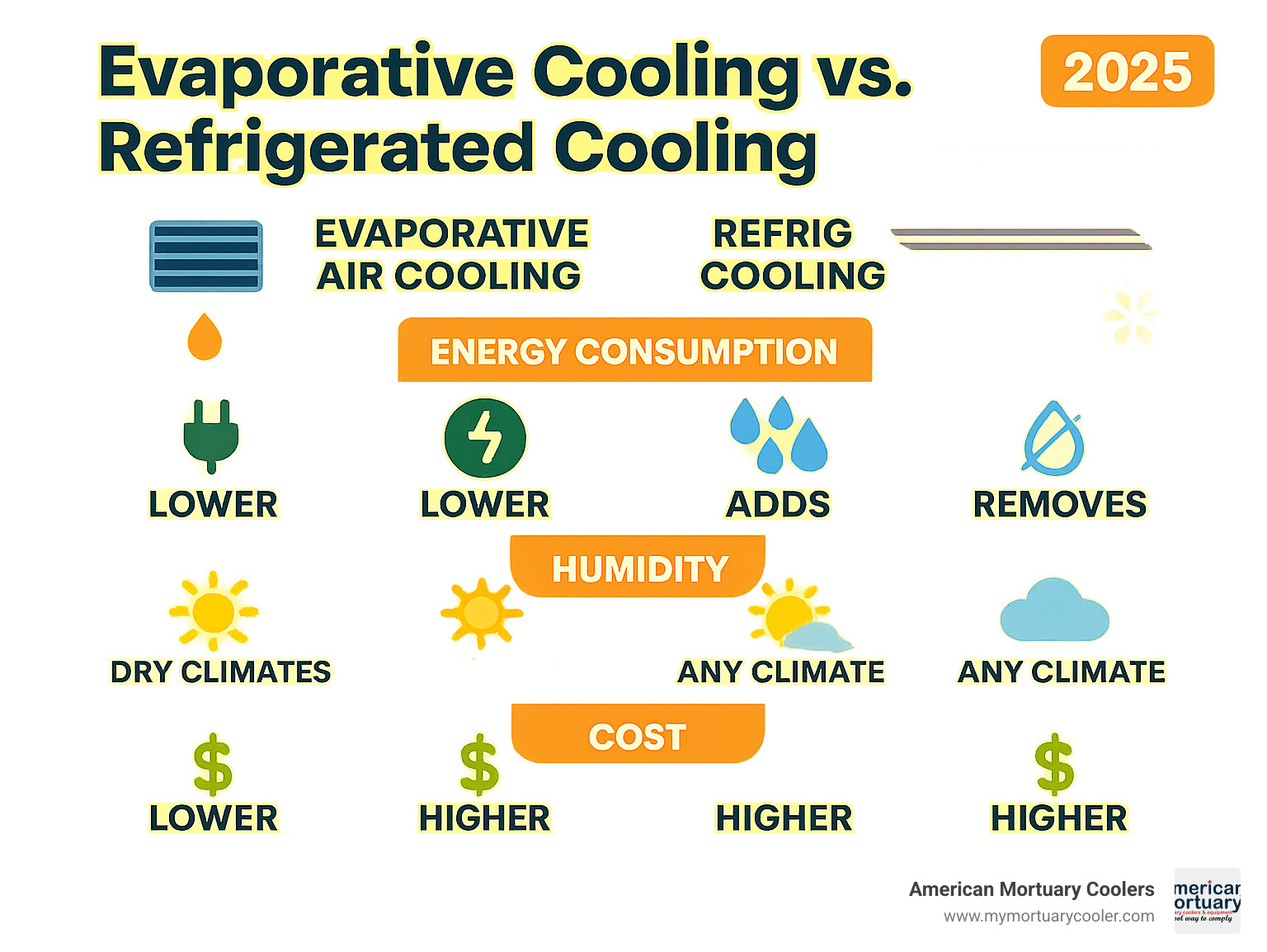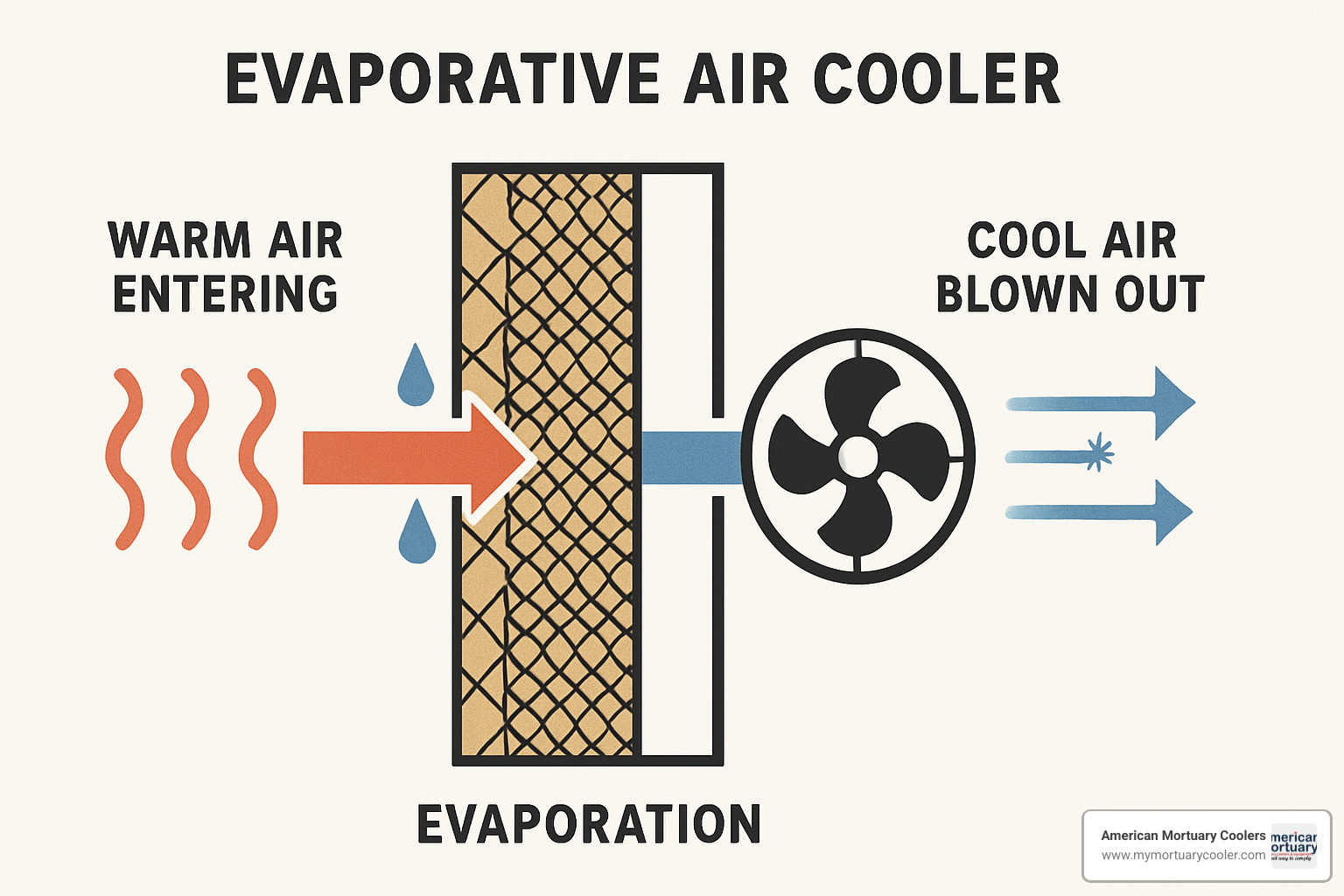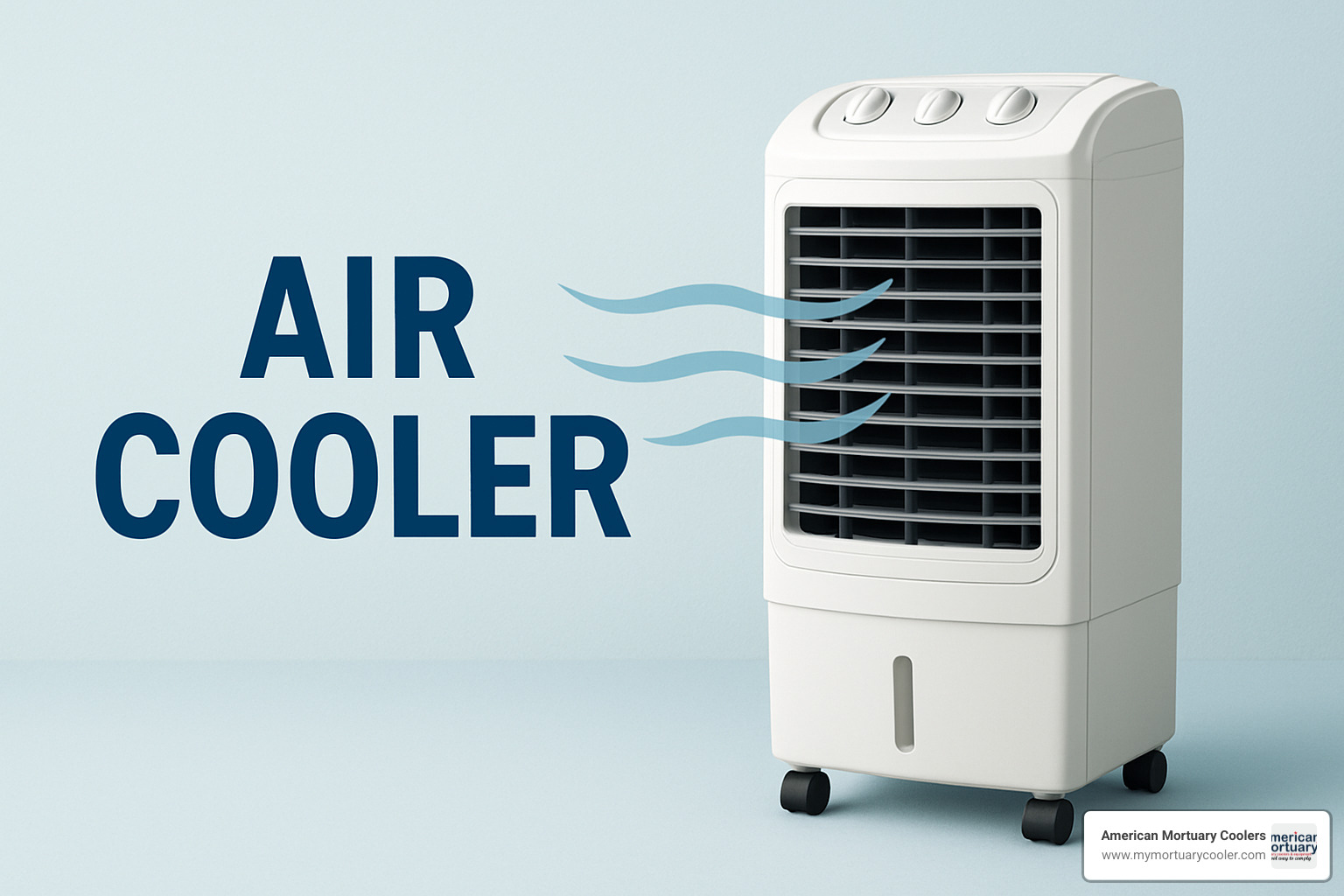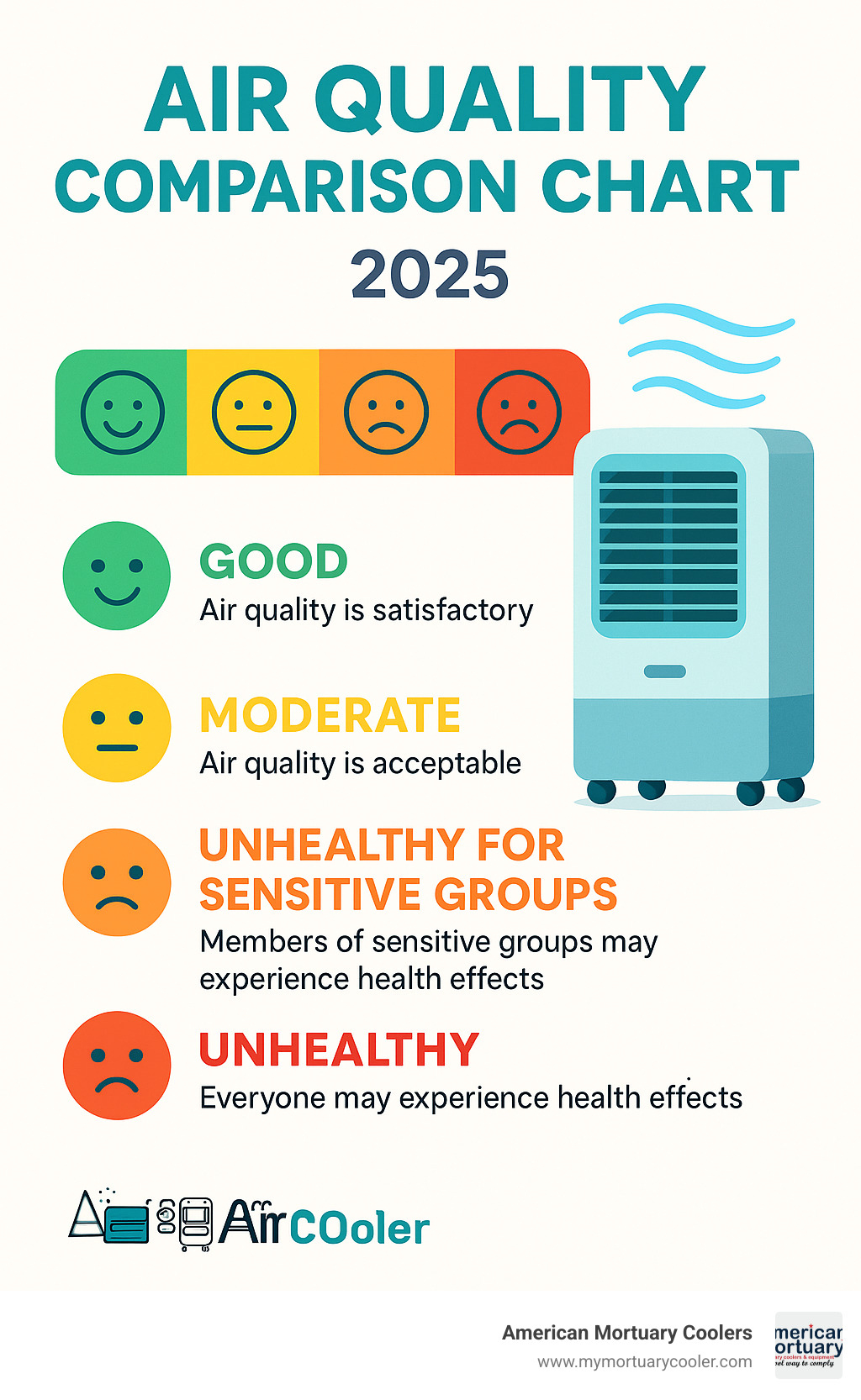
A Comprehensive Guide to Comparing Air Cooler Options
Why Air Coolers Are the Smart Alternative to Traditional AC
An air cooler is a device that cools air through water evaporation, using up to 75% less electricity than traditional air conditioners while adding beneficial humidity to dry environments.
Quick Air Cooler Comparison:
- Evaporative Air Coolers: Use water evaporation, add humidity, work best in dry climates
- vs. Air Conditioners: Use refrigerant cycles, remove humidity, work in any climate but consume more power
- vs. Fans: Only circulate existing air without cooling it
- Power Usage: Average 193W (equivalent to two 100W light bulbs)
- Coverage: From 45 sq ft (personal units) to 6,500 sq ft (whole-house models)
Air coolers work by pulling warm air through water-saturated honeycomb pads, where evaporation naturally cools the air before a fan distributes it throughout your space. This process mimics how perspiration cools your body, making it a chemical-free and energy-efficient cooling solution.
These devices shine in hot, dry climates where humidity levels are low. Unlike air conditioners that rely on compressors and refrigerants, air coolers simply need water and airflow to operate effectively. They're particularly valuable for spaces that need supplemental cooling without the high energy costs of traditional AC systems.
As American Mortuary Coolers, we've spent years helping facilities find efficient cooling solutions that balance performance with operational costs. Our experience with air cooler systems has shown us how these units can provide reliable temperature control while keeping energy expenses manageable, especially in specialized environments where consistent cooling is essential.

How Does an Air Cooler Work?
Think of an air cooler like nature's own cooling system - it works exactly the same way your body cools itself when you sweat. The science is surprisingly simple, yet incredibly effective.
When you turn on an air cooler, warm air gets pulled through special honeycomb pads that are soaked with water. These pads aren't just any old material - they're designed with tons of tiny spaces that maximize contact between the air and water. As the warm air passes through, something magical happens: the water molecules absorb heat energy from the air and transform into invisible vapor.
This evaporation process is what does all the heavy lifting. The water literally steals heat from the air to change from liquid to gas, leaving behind air that's 15-40 degrees cooler than when it started. It's the same reason you feel chilly when you step out of a swimming pool on a breezy day.
The fan airflow then pushes this newly cooled air into your space. The whole system draws just 193 watts of power - about the same as running two regular light bulbs. Compare that to a traditional air conditioner gulping down 3,000-5,000 watts, and you can see why your electricity bill will thank you.
Here's the catch though: this works best when humidity is low. Dry air is like a thirsty sponge - it's eager to absorb more moisture. But if the air is already saturated with humidity, there's nowhere for that water to go, and the cooling effect fizzles out. According to scientific research on climate suitability, certain regions of the US are perfect for this type of cooling while others aren't.

Air Cooler vs. Air Conditioner: The Science
The difference between an air cooler and an air conditioner is like comparing a gentle stream to a complex factory. Air conditioners are mechanical marvels that use a refrigerant cycle - they compress chemical gases, pump them through coils, and force them to change states under pressure. It's effective, but it requires a power-hungry compressor that's basically a heavy-duty pump working overtime.
Air coolers take the compressor-free approach. No chemicals, no high-pressure systems, no complex machinery. Just water, air, and the laws of physics doing what they've done for millions of years.
There's another key difference: while air conditioners suck moisture out of your air (ever notice that water dripping from AC units?), air coolers actually add humidity. In dry climates, this is a bonus - it can help with dry skin, static electricity, and respiratory comfort. But in already humid places, it can make things feel sticky and uncomfortable.
Air Cooler vs. Standard Fan: Key Differences
A regular fan is like having someone wave a piece of cardboard at you - it moves air around and creates a breeze, but it doesn't actually change the temperature of that air. You feel cooler because the moving air helps your sweat evaporate faster, but if you put a thermometer in the room, it would read exactly the same.
An air cooler actually delivers cooler air. While a fan might make 85°F feel like 80°F through air circulation, an air cooler can push out genuine 70°F air when conditions are right. That's real cooling, not just the sensation of it.
The comfort level difference is night and day. With a fan, you're still breathing the same hot air - it's just moving. With an air cooler, you're getting a steady stream of air that's been naturally chilled by evaporation. It's like the difference between sitting in a hot car with the windows down versus having actual cool air blowing on you.
Choosing the Right Air Cooler Size & Type
Finding the perfect air cooler feels a bit like Goldilocks and the Three Bears - you need one that's just right for your space. Too small, and you'll be disappointed with weak cooling. Too large, and you're wasting energy and money on capacity you don't need.
Let's start with the smallest option: portable desk units. These little workhorses cover about 45 square feet, making them perfect for your personal workspace or bedside table. Most plug right into a USB port and hold enough water for 4-8 hours of cooling. They're surprisingly effective for what they are - think of them as your personal cooling bubble.
Room tower units step things up considerably, handling anywhere from 100-500 square feet with ease. These are the sweet spot for most people - tall enough to cool a bedroom or office, portable enough to wheel from room to room. Many come with oscillation features that sweep cool air across the entire space, plus remote controls so you don't have to get up to adjust settings.
Window-mount units work much like window air conditioners but use evaporation instead of refrigerants. They're ideal when you want something more permanent that can cool 300-700 square feet. The built-in thermostats on these models help maintain consistent temperatures automatically.
For serious cooling needs, whole-house systems bring industrial-strength performance to residential and commercial spaces. Models like the Big Ass Fans Cool-Space 500 can cool up to 6,500 square feet with an impressive 24,000 CFM airflow capacity. These aren't for everyone, but when you need serious cooling power, nothing else comes close.
The key is matching your air cooler to your actual needs rather than going bigger "just in case." A properly sized unit will cool more effectively and use energy more efficiently than an oversized one running at low capacity.

Calculating CFM for Your Air Cooler
CFM (Cubic Feet per Minute) might sound technical, but it's really just measuring how much air your air cooler can push around. Think of it as the lungs of your cooling system - bigger lungs move more air, creating better cooling.
The basic math is refreshingly simple: take your room's volume in cubic feet and divide by two. That gives you the minimum CFM you need. But here's where it gets practical: 200 CFM works for about 50 square feet, while 5,300 CFM can handle around 1,600 square feet. Most manufacturers make this easy by listing the square footage coverage right on the box.
Real-world conditions often demand more than the basic calculation suggests. If your space has ceilings above 10 feet, large sun-facing windows, or heat-generating equipment, plan on adding 20-30% to your calculated CFM needs. We've learned from years of cooling specialized facilities that it's better to have slightly more capacity than to struggle with an undersized unit.
Here's a helpful reference: 1,000 CFM typically handles about 250 square feet, and 2,000 CFM covers roughly 500 square feet. These numbers assume standard 8-foot ceilings and moderate heat loads, so adjust accordingly for your specific situation.
More info about choosing capacity
Best Climates for Air Cooler Performance
Air coolers are picky about where they work best, and honestly, that's perfectly fine. They absolutely shine in hot, dry areas like Arizona, Nevada, Colorado, and parts of California. These regions combine scorching temperatures with low humidity - exactly what evaporative cooling loves.
The magic number for humidity is 60% or below. When humidity stays in this range, your air cooler can work efficiently, pulling heat from the air as water evaporates. Push much above 60% humidity, and the process slows down significantly. In places like the humid Southeast where summer humidity often hits 70-80%, air coolers might actually make you less comfortable by adding unwanted moisture to already sticky air.
Here's something many people don't realize: air coolers need ventilation to work properly. Unlike air conditioners that seal you into a climate-controlled bubble, air coolers work best with a little airflow through the space. Opening a window or door slightly lets the humid air escape while drawing in fresh, dry air for the cooling process.
If you're in a borderline climate zone, pay attention to your local humidity patterns. Many areas that seem too humid overall actually have dry periods when air coolers work beautifully. The key is understanding your specific microclimate and using your air cooler during optimal conditions.
Feature Checklist When Buying an Air Cooler
Shopping for an air cooler can feel overwhelming with so many options available, but focusing on the right features will help you find the perfect match for your needs. After years of helping customers choose cooling solutions, we've learned which features truly matter and which are just marketing fluff.
Water tank capacity should be your first consideration. Think about how often you want to refill the unit - desktop models with their 1-2 liter tanks work fine for short-term use, but if you're cooling a room all day, you'll appreciate the 10-20 liter tanks found in larger portable units. Calculate your runtime needs based on how you actually plan to use the cooler.
Multiple fan speeds give you control over both cooling power and noise levels. Look for at least three speed options, though some premium models offer variable speed control that lets you dial in exactly the airflow you want. This flexibility becomes especially valuable when you're trying to balance cooling performance with peaceful operation during sleep or work.
Remote control capability might seem like a luxury, but it's practically essential for larger units or when your air cooler sits across the room. Many newer models even include smartphone apps, though a simple remote usually does the job just fine.
Some units come with ice pack compatibility - special freezable packs that boost cooling capacity when temperatures soar. These can make a noticeable difference during heat waves, though they're not necessary for everyday use.
Noise levels matter more than most people realize. Check the decibel ratings if you plan to use your air cooler in bedrooms or quiet workspaces. Quality units typically operate at 35-45 dB on low settings - about as quiet as a library.
Portability features like sturdy casters and comfortable carrying handles make a huge difference if you plan to move your unit between rooms. Some models fold down or have compact designs that make storage easier too.
Energy efficiency features like variable-speed motors can significantly reduce your operating costs. Look for models with energy-efficient fans and smart controls that adjust power consumption based on actual cooling needs.
Don't overlook maintenance requirements when making your choice. Consider how often you'll need to replace honeycomb pads (typically every 3-5 years with proper care) and how easy it is to clean the water tank and other components.
More info about portable air cooler checklist
Must-Have Features for an Energy-Smart Air Cooler
Variable-speed motors top our list of energy-saving features because they automatically adjust power consumption based on cooling demand. This smart technology can reduce energy use by 40-60% compared to basic single-speed models - a difference you'll notice on your electric bill.
Timer functions prevent your air cooler from running unnecessarily by automatically shutting off after preset periods. This feature proves especially valuable for nighttime cooling or when you're stepping out but want to return to a cool space.
Low-water alerts protect both your investment and your cooling performance. These systems prevent dry operation that can damage pumps and eliminate cooling effectiveness. Advanced models include automatic shut-off when water levels drop too low, giving you complete peace of mind.
Health & Air Quality Considerations in Air Cooler Use
Air coolers can actually improve your indoor air quality in dry environments by adding beneficial humidity to overly dry air. However, like any appliance that uses water, they require proper maintenance to keep your air healthy and fresh.
The added moisture from evaporative cooling can support mold growth if water sits stagnant or if you operate the unit in already humid conditions. Quality filter media helps trap dust and allergens while maintaining proper airflow, but you'll need to replace or clean these filters regularly according to the manufacturer's schedule.
Preventing mold requires simple but consistent habits. Drain water tanks when you're not using the unit, clean tanks weekly with a mild bleach solution, replace honeycomb pads annually, and ensure adequate ventilation in your space. These steps take just minutes but prevent problems that could affect your health.
The humidity boost from air coolers often benefits people with respiratory issues in dry climates, helping to soothe irritated airways and reduce static electricity. However, in already humid environments, the additional moisture might worsen conditions for some individuals.
Proper ventilation remains crucial for both performance and health. Unlike air conditioners that work in sealed spaces, air coolers need fresh air circulation to function effectively and prevent moisture buildup that could lead to air quality issues.

Top Air Cooler Models & Use-Case Roundup
Finding the right air cooler can feel overwhelming with so many options available. We've tested and evaluated dozens of models across different categories, and honestly, most fall into predictable patterns. The key is matching your specific situation with the right cooling capacity and features.
Let me walk you through our top picks for each use case, based on real-world performance rather than marketing promises.
Best Personal Air Cooler for Desks
For personal workspace cooling, the Evapolar USB air cooler consistently outperforms its competitors in the compact category. This little powerhouse covers about 45 square feet effectively - perfect for your immediate desk area without overwhelming your coworkers.
What makes this unit special is its whisper-quiet operation under 35 decibels. You can run it during video calls without anyone noticing. The USB power connection means you can plug it into your laptop or use a power bank, making it genuinely portable between workspaces.
The 4-6 hour runtime per water fill works well for most office schedules. You'll need to refill it once or twice during a full workday, but the compact water reservoir makes this quick and easy. The adjustable air direction lets you customize the cooling exactly where you need it.
This model shines in air-conditioned offices where you want additional personal cooling without fighting the existing HVAC system. It's not meant to cool an entire room, but for targeted personal comfort, it's hard to beat.
Best Small-Room Air Cooler
The Honeywell CS071AE strikes the perfect balance for small spaces up to 175 square feet. With 176 CFM airflow capacity, it provides genuine room cooling rather than just personal comfort. We particularly appreciate its quiet mode operation, which keeps noise levels comfortable for bedroom use.
The 1.6-gallon water tank gives you several hours of continuous cooling without constant refills. Three-speed fan control lets you adjust between gentle overnight cooling and more aggressive daytime performance. The included dust filter helps maintain air quality while the compact footprint with casters makes repositioning effortless.
This model works exceptionally well in apartments, bedrooms, or small offices where you need reliable cooling without the expense of running central air. The price point makes it accessible for most budgets while delivering consistent performance in appropriate climates.
Best Mid-Size Portable Air Cooler
When you need serious cooling power for larger spaces, the Hessaire 3100 CFM unit delivers impressive performance up to 950 square feet. This swamp cooler design provides the cooling capacity of much larger systems while maintaining true portability through heavy-duty casters.
The 3,100 CFM airflow capacity means business - you'll feel the cooling effect immediately in medium to large rooms. The substantial 9.2-gallon water tank provides extended runtime, typically lasting 8-12 hours depending on conditions and speed settings.
Variable speed control lets you fine-tune performance based on conditions and noise preferences. The robust construction handles both indoor and outdoor use, making it versatile for workshops, garages, patios, or large living spaces.
We recommend this model when traditional air conditioning becomes too expensive to operate for larger areas. It's particularly effective in dry climates where the evaporative cooling process works most efficiently.
Best Whole-House Air Cooler
For maximum coverage, the Big Ass Fans Cool-Space 500 handles up to 6,500 square feet with its impressive 24,000 CFM capacity. This industrial-grade air cooler features 11-speed control and construction quality that handles demanding applications.
The 24,000 CFM maximum airflow moves serious amounts of air - enough to create noticeable cooling in warehouses, large workshops, or open-plan residential spaces. Eleven-speed variable control provides precise adjustment from gentle circulation to maximum cooling power.
Professional installation is typically recommended due to the unit's size and electrical requirements, but the performance justifies the investment in appropriate applications. This model excels where traditional air conditioning would be prohibitively expensive to install or operate.
The heavy-duty construction handles continuous operation in challenging environments, making it suitable for commercial and industrial applications as well as residential use.
Frequently Asked Questions about Air Coolers
How much electricity does an air cooler use?
Here's some great news for your electricity bill: air coolers are incredibly energy-efficient compared to traditional cooling methods. Most units consume between 150-250 watts during operation, with the sweet spot around 193W. To put that in perspective, that's about the same power draw as running two standard 100W light bulbs.
The real magic happens when you compare this to air conditioning. Air coolers use roughly 75% less electricity than comparable AC units. If you're running your air cooler for 8 hours a day, you're looking at daily costs of just $0.15 to $0.25 in most areas. Compare that to $1.50 to $3.00 for equivalent air conditioning, and the savings add up fast.
At American Mortuary Coolers, we've seen facilities dramatically reduce their cooling costs by switching to evaporative systems in appropriate climates. The math simply works in your favor.
Can I run an air cooler with my central AC or heat?
Absolutely! Air coolers make excellent teammates with your existing HVAC systems. During those scorching summer months, running an air cooler alongside your central AC can actually boost overall cooling effectiveness while keeping your energy bills in check. Think of it as giving your AC a helpful assistant.
The winter months offer another benefit entirely. Running your air cooler at low speed during heating season adds much-needed humidity to combat that dry indoor air that heating systems create. Your skin, throat, and houseplants will thank you.
The secret to success is proper ventilation. Crack a window slightly when your air cooler is running. This prevents over-humidification and keeps air circulation optimal. It might seem counterintuitive, but that little bit of fresh air exchange makes all the difference.
What maintenance do air coolers require?
Air coolers are refreshingly low-maintenance compared to complex AC systems, but a little regular care keeps them running like champions. Think of it as basic housekeeping rather than major mechanical work.
Your weekly routine should include emptying and refilling the water tank with fresh water, plus a quick wipe-down of exterior surfaces. This prevents stagnant water issues and keeps everything looking clean.
Monthly maintenance involves giving those honeycomb pads a gentle rinse with clean water and checking for any mineral buildup. Hard water areas might need this attention more frequently.
Seasonal deep cleaning means thoroughly cleaning the tank with a mild bleach solution and inspecting the fan operation. This is also a good time to check that everything's running smoothly before heavy-use seasons.
Annual maintenance typically requires replacing the honeycomb pads and lubricating fan bearings if your model requires it. Most honeycomb pads last 3-5 years with proper care, but annual replacement ensures peak performance.
This maintenance routine prevents mold growth, maintains cooling efficiency, and significantly extends your unit's lifespan. We've seen well-maintained air coolers provide reliable service for many years with just these simple care steps.
Conclusion
Choosing the right air cooler can transform how you think about cooling your space. These remarkable devices offer a perfect blend of energy efficiency, environmental responsibility, and genuine comfort - especially when you match them to the right climate and application.
Here at American Mortuary Coolers, we've learned a thing or two about keeping things cool over the years. Our work across Tennessee, Georgia, Illinois, and throughout the country has taught us that smart cooling isn't just about dropping temperatures - it's about finding solutions that work reliably day after day without breaking the bank on energy costs.
The beauty of air coolers lies in their honest simplicity. No complex refrigerant systems, no sky-high electric bills, just the natural power of evaporation doing what it does best. Whether you're looking at a compact desktop unit for your home office or considering a whole-house system for your workshop, there's likely an air cooler that fits both your space and your budget.
What we find most encouraging is how these units align with both eco-friendly values and practical needs. Using 75% less electricity than traditional AC while adding beneficial humidity to dry environments? That's the kind of win-win solution that makes sense for both your wallet and the planet.
The key to success with any air cooler is understanding your specific situation. Hot, dry climate? You're in the sweet spot. Need supplemental cooling without the energy drain? Perfect application. Want reliable temperature control that won't surprise you with massive utility bills? Now we're talking.
While our specialty lies in custom cooling solutions for specialized applications, we believe everyone deserves access to efficient, affordable climate control. The air cooler options we've covered represent proven technologies that deliver real results when properly matched to their intended use.



